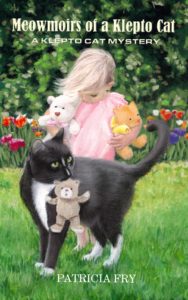 One of my challenges as the author of cozy mysteries with cats is creating titles for so many books. By comparison, it’s easy to come up with titles for nonfiction books. In order to attract the right readers for your nonfiction book, you must be literal in your presentation of it; and a major part of that presentation is the title and subtitle. Here are some examples of my nonfiction book titles. The Mainland Luau; How to Capture the Flavor of Hawaii in Your Own Backyard. And how about this one: Youth Mentoring; Sharing Your Gifts With the Future? And this one: Creative Grandparenting Across the Miles; Ideas for Sharing Love, Faith, and Family Traditions. These titles pretty much describe the book you’re about to buy. Then there are my publishing-related books, for example, Propose Your Book, How to Craft Persuasive Proposals for Nonfiction, Fiction and Children’s Books and A Writer’s Guide to Magazine Articles.
One of my challenges as the author of cozy mysteries with cats is creating titles for so many books. By comparison, it’s easy to come up with titles for nonfiction books. In order to attract the right readers for your nonfiction book, you must be literal in your presentation of it; and a major part of that presentation is the title and subtitle. Here are some examples of my nonfiction book titles. The Mainland Luau; How to Capture the Flavor of Hawaii in Your Own Backyard. And how about this one: Youth Mentoring; Sharing Your Gifts With the Future? And this one: Creative Grandparenting Across the Miles; Ideas for Sharing Love, Faith, and Family Traditions. These titles pretty much describe the book you’re about to buy. Then there are my publishing-related books, for example, Propose Your Book, How to Craft Persuasive Proposals for Nonfiction, Fiction and Children’s Books and A Writer’s Guide to Magazine Articles.
Yes, these titles are fairly straightforward and will attract the reader for whom the book is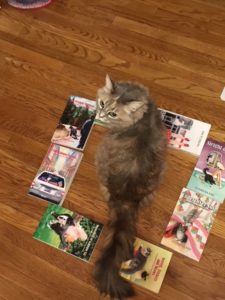 intended. But it’s not as easy to capture the essence of your story in a brief title for fiction. I tell authors that if the main title isn’t descriptive, always use a subtitle—yes, even in fiction. My subtitle for my novels is always “A Klepto Cat Mystery.” Then folks know this is a mystery and part of a series and it involves a cat—one that presumably takes things. They get the idea that this story is fun, probably light, and entertaining. This is a technique used by many novelists.
intended. But it’s not as easy to capture the essence of your story in a brief title for fiction. I tell authors that if the main title isn’t descriptive, always use a subtitle—yes, even in fiction. My subtitle for my novels is always “A Klepto Cat Mystery.” Then folks know this is a mystery and part of a series and it involves a cat—one that presumably takes things. They get the idea that this story is fun, probably light, and entertaining. This is a technique used by many novelists.
If the author insists on using a one- or two-word title such as, “Abandoned,” “Forgotten,” “The Girl on the Train,” “Shattered,” “Lonesome Dove,” for example it helps the potential reader if you explain further on the cover. You can do this sometimes adequately and sometimes only partially through your cover design. But still the reader wants to know is it a novel, a memoir, true account or 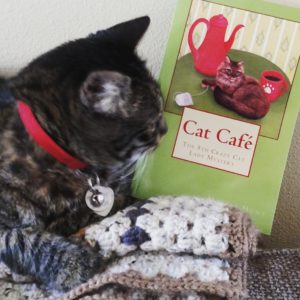 what? I suggest adding “A Novel,” “Memoir of a Street Urchin” (War Veteran, Holocaust Survivor, etc.) or “A True Story.” You can see that my friend Mollie Hunt has done this with her series of cozy mysteries. The title of this book is “Cat Cafe.” The subtitle says, “The Fifth Crazy Cat Lady Mystery.”
what? I suggest adding “A Novel,” “Memoir of a Street Urchin” (War Veteran, Holocaust Survivor, etc.) or “A True Story.” You can see that my friend Mollie Hunt has done this with her series of cozy mysteries. The title of this book is “Cat Cafe.” The subtitle says, “The Fifth Crazy Cat Lady Mystery.”
With fiction, titles are not as direct and this is why I spend so much time trying to create titles for my Klepto Cat Mysteries. I’ve complicated matters by always using a word indicative of cats—even if it means I have to create new words—MEOWvelous, for example, PAWtners, PURRfect, PURRsuit and so forth. And I use catty phrases, such as “By Crook or By Cat,” “Catnapped,” “Mansion of Meows,” “Claws for a Cause,” and “Cats in Cahoots.”
When I hear a new use of a cat-related word, I write it down. I have a file folder full of cat-related terms I could possibly twist into a meaningful title—aMEWsing, PAWssible, CATastic, PURRpose, Felinest, HISSterical. Fun, isn’t it? But after having created titles for 33 books in the series, it can become a bit overwhelming. So any ideas you want to send my way, I’d appreciate. PLFry620@yahoo.com. (By the way, yes, Book 32 is with the editor as we speak–the title is fixed, and I’m working on Book 33 with a working title in place.)


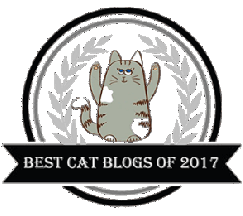

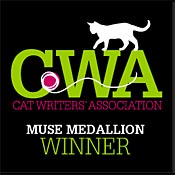
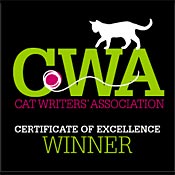
Tyler thanks you for posting his picture that, incidentally, also shows the cover of my new book.
Yes, titles are a quandary. They need to be catchy to lure a reader, yet also say something about the book.